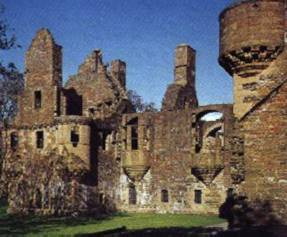History of the Stewarts | Castles and Buildings
If you are a Stewart Society Member please login above to view all of the items in this section. If you want general information on how to research your ancestors and some helpful links - please look in background information.
If you have a specific question you can contact our archivist.

Bishop's Palace, Kirkwall - 12th century hall-house
The Bishop´s Palace was built in the mid-12th century for Bishop William the Old - a friend and crusading companion of Earl Rognvald Kolsson, the founder of St Magnus Cathedral in Kirkwall. King Haakon of Norway died here after his defeat at battle of Largs.
The palace was originally intended to provide accommodation for Bishop William and his household. So, shortly after the construction work on the cathedral began, the Bishop moved from his previous seat of power in Birsay to his new palace in Kirkwall. At this time, it is likely that the building conformed to the plan of a Norwegian royal palace - consisting of a hall, used for entertaining, and a tower house that was the Bishop´s private residence.
By 1320, the palace had been reduced to ruins through neglect. However the building returned to prominence in 1540, when King James V arrived in Kirkwall and garrisoned his troops in the Kirkwall Castle and the Bishop´s Palace.
In 1568, the ownership of the palace passed to Earl Robert Stewart. Robert´s son, Patrick Stewart, later planned to include the structure in his scheme to build the Earl´s Palace, a massive residence in Kirkwall. But Patrick´s plans never came to fruition and, in 1607, "drowned in debt", he was forced to return the complex to Bishop James Law.In 1614, both palaces were seized by Robert Stewart - Earl Patrick´s son - who staged a rebellion following the incarceration of his father for treason. This resulted in a siege, but whether the action taken against the Stewarts actually damaged the Bishop´s Palace is unknown. The rising was put down by the Earl of Caithness, and Patrick and Robert Stewart were both executed in Edinburgh in 1615.
The Bishops of Orkney occupied the palace until 1688 after which it became ruinous.
The ruins visible in Kirkwall now in no way show the full extent of the building in its heyday.
The Society visited here in 2017 during the Society Gatheriing in Orkney.
Thanks to Historic Scotland and Orkneyjar websites
The palace was originally intended to provide accommodation for Bishop William and his household. So, shortly after the construction work on the cathedral began, the Bishop moved from his previous seat of power in Birsay to his new palace in Kirkwall. At this time, it is likely that the building conformed to the plan of a Norwegian royal palace - consisting of a hall, used for entertaining, and a tower house that was the Bishop´s private residence.
By 1320, the palace had been reduced to ruins through neglect. However the building returned to prominence in 1540, when King James V arrived in Kirkwall and garrisoned his troops in the Kirkwall Castle and the Bishop´s Palace.
In 1568, the ownership of the palace passed to Earl Robert Stewart. Robert´s son, Patrick Stewart, later planned to include the structure in his scheme to build the Earl´s Palace, a massive residence in Kirkwall. But Patrick´s plans never came to fruition and, in 1607, "drowned in debt", he was forced to return the complex to Bishop James Law.In 1614, both palaces were seized by Robert Stewart - Earl Patrick´s son - who staged a rebellion following the incarceration of his father for treason. This resulted in a siege, but whether the action taken against the Stewarts actually damaged the Bishop´s Palace is unknown. The rising was put down by the Earl of Caithness, and Patrick and Robert Stewart were both executed in Edinburgh in 1615.
The Bishops of Orkney occupied the palace until 1688 after which it became ruinous.
The ruins visible in Kirkwall now in no way show the full extent of the building in its heyday.
The Society visited here in 2017 during the Society Gatheriing in Orkney.
Thanks to Historic Scotland and Orkneyjar websites
Reference: Historic Scotland

